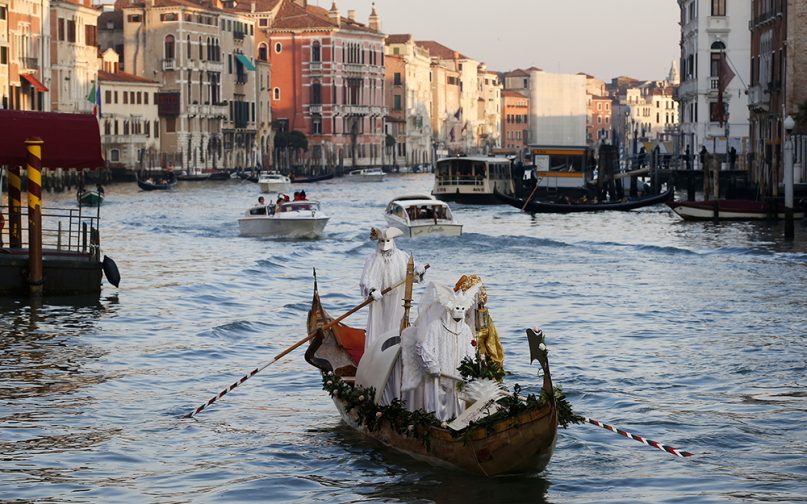(RNS) — In Venice, where I am attending the festival known as Carnevale, the streets swarm with would-be revelers, and it is impossible to see out of the windows at Café Florian on Piazza San Marco for all of the Instagram photographers who stand outside them, taking pictures of costumed masqueraders, rapping on the glass to get their attention or to get that perfect shot.
It’s easy to forget, amid all the chaos, that this holiday is of course a religious one: the two or so weeks before Fat Tuesday (or Mardi Gras, as it is often known). And then Ash Wednesday: the beginning of the penitential season of Lent. Carnevale is a period of excess before fasting, of chaos before quietude.
The old bonds fostered by a church or synagogue or mosque — the official rites of passage as well as the more social sides of our communities of faith — are increasingly weakening. But in an age of spiritual uncertainty, more and more of us are finding our spiritual “tribes” within these existing religious traditions, be they pagan nature worship or medieval Catholicism.
For me, it was Carnevale. A few years before I returned to conscious Christianity, I started attending the Carnevale here on the recommendation of a close friend I knew through the international vintage clothing scene. About 200 or so people, mostly Italian and French with a smattering of Germans and Americans, came annually not to attend the publicly sanctioned parties of Carnevale, which can run easily up to 1,000 euros per ticket, but to attend smaller private parties at people’s homes or expressly rented palazzos.
These parties are not commercial propositions — the entry fee generally just about covers the cost of catering staff and copious amounts of prosecco — but, rather, gatherings of like-minded friends: people whose love of history, of beauty, of historical costuming or poetic nostalgia or dressing up or theatricality brings them back, every year, into the group that has become known as “the family.”

Masked people stand on a gondola as part of Carnevale in Venice, Italy, on Feb. 16, 2019. Carnevale indulgences lead up to Lent, which highlights sacrifices before Easter. (AP Photo/Antonio Calanni)
Some of the attendants are professional costumers, tailors or wigmakers; others have so-called normal jobs but design their own costumes or have them made by professionals; still others scour thrift stores and theater sales for their clothing. Some costumes are impeccably historically accurate; others are creative reinventions made of latex or leather. One attendee with a fondness for the late Austro-Hungarian Empire comes to every party dressed as some variant of the Empress Sisi, the wife of Emperor Franz Joseph I.
Themes for these parties, which run from ancient Greece or Babylon to fairy tales and fables to obscure decades in historical fashion, are announced six months in advance. Most people spend an entire year preparing their costumes, not to impress or to be photographed — photography is relatively rare on these parties, and being constantly on one’s phone a social faux pas — but to co-create an atmosphere of poetic intensity in which each participant has contributed, by virtue of their labor and attention and care, to the creation of a surreal world. Some participants have been coming for 10, or even 20, years — or more.
I expected to go to Carnevale, once, on a lark, attending a couple of parties in borrowed clothes. Three years later, I am bringing my own initiates, dressing them with my own costumes from Carnevales past.
But Carnevale was something else, too: a kind of Durkheimian church, a community that I fostered around myself and one of the many way stations on my return to faith. At Carnevale, I found my “tribe” — a group of people who celebrated not just in the two weeks leading up to Lent but also commemorated the life stages of its members, from marriages (and broken engagements) to deaths. When one of our “family” passed away, we held a candlelight vigil for him in Venice, near to the restaurant where we’d all celebrated together so many times.
Only 22% of Americans today have their weddings in religious buildings, about half of what it was a decade ago. Thirty percent plan to have secular funerals. While the values of Carnevale are not explicitly metaphysical, each time I’ve returned to Venice, I’ve found in the nightly parties, the promenades to Café Florian, a shared sense of wonder, an idealistic vision of the possibility of beauty — both the beauty of nostalgia and the forward-looking beauty of creativity — to help reach transcendence. “It’s better than therapy,” one of my friends, a long-standing host of the annual parties, told me last year.
For me, Carnevale’s beauty, its appreciation of ritual and its celebration of family foreshadowed a life I rediscovered, in full, when going back to church. But even for its seemingly secular members, Carnevale offers us more than just a week of parties. It reveals how blurred the boundaries are between subculture, cult and family.






